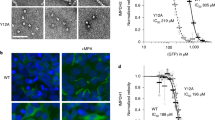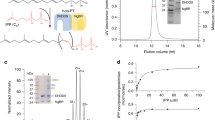Abstract
Mutations in the retinal inosine monophosphate dehydrogenase1 (IMPDH1) gene is believed to be one cause of retinitis pigmentosa (RP). The main structural difference between the mutation-susceptible retinal isoforms with canonical one resides in the C- and N-terminal extensions. There are limited studies on the structure and function of terminal peptide extensions of the IMPDH1 retinal isoforms. Using recombinant murine IMPDH1 (mH1), we evaluated the kinetics of the retinal isoforms along with inhibition by some of the purine nucleotides. Molecular modeling tools were also applied to study the probable effect(s) of the terminal peptide tails on the function of the retinal isoforms. Molecular dynamic simulations indicated the possible impact of the end-terminal segments on the enzyme function through interactions with the enzyme’s finger domain, affecting its critical pseudo barrel structure. The higher experimentally-determined Km and Ki values of the retinal mIMPDH1 (546) and mIMPDH1 (603) relative to that of the canonical isoform, mIMPDH1 (514), might clearly be due to these interactions. Furthermore and despite of the canonical isoform, the retinal isoforms of mH1 exhibited no NAD+ substrate inhibition. The resent data would certainly provide the ground for future evaluation of the physiological significance of these variations.








Similar content being viewed by others
References
Spellicy CJ, Xu D, Cobb G et al (2010) Investigating the mechanism of disease in the RP10 form of retinitis pigmentosa. Adv Exp Med Boil 664:541–548. https://doi.org/10.1007/978-1-4419-1399-9_62
Kennan A, Aherne A, Palfi A et al (2002) Identification of an IMPDH1 mutation in autosomal dominant retinitis pigmentosa (RP10) revealed following comparative microarray analysis of transcripts derived from retinas of wild-type and Rho(/) mice. Hum Mol Genet 11:547–557. https://doi.org/10.1007/978-1-4615-0067-4_2
Bowne S, Sullivan L, Blanton S et al (2002) Mutations in the inosine monophosphate dehydrogenase 1 gene (IMPDH1) cause the RP10 form of autosomal dominant retinitis pigmentosa. Hum Mol Genet 11(5):559–568. https://doi.org/10.1093/hmg/11.5.559
Bowne S, Sullivan L, Mortimer S et al (2006) Spectrum and frequency of mutations in IMPDH1 associated with autosomal dominant retinitis pigmentosa and leber congenital amaurosis. Invest Ophthalmol Vis Sci 47(1):34–42. https://doi.org/10.1167/iovs.05-0868
Hedstrom L (1999) IMP dehydrogenase: mechanism of action and inhibition. Curr Med Chem 6:545–560. https://doi.org/10.1021/cr900021w
Bowne S, Liu Q, Sullivan LS et al (2006) Why do mutations in the ubiquitously expressed housekeeping gene IMPDH1 cause retina-specific photoreceptor degeneration? Invest Ophthalmol Vis Sci 47(9):3754–3765. https://doi.org/10.1167/iovs.06-0207
Spellicy C, Daiger S, Sullivan L et al (2007) Characterization of retinal inosine monophosphate dehydrogenase 1 in several mammalian species. Mol Vis 13:1866–1872
Gunter JH, Thomas EC, Lengefeld N et al (2008) Characterization of inosine monophosphate dehydrogenase expression during retinal development: differences between variants and isoforms. Int J Biochem Cell Biol 40(9):1716–1728. https://doi.org/10.1016/j.biocel.2007.12.018
Hedstrom L (2009) IMP dehydrogenase: structure, mechanism and inhibition. Chem Rev 109(7):2903–2928. https://doi.org/10.1021/cr900021w
Hedstrom L (2008) IMP dehydrogenase-linked retinitis pigmentosa. Nucleosides, Nucleotides Nucleic Acids 27(6):839–849. https://doi.org/10.1080/15257770802146486
Mortimer SE, Xu D, McGrew D et al (2008) IMP dehydrogenase type 1 associates with polyribosomes translating rhodopsin mRNA. J Biol Chem 283(52):36354–36360. https://doi.org/10.1074/jbc.M806143200
Kozhevnikova EN, Van der Knaap JA, Pindyurin AV et al (2012) Metabolic enzyme IMPDH is also a transcription factor regulated by cellular state. Mol Cell 47(1):133–139. https://doi.org/10.1016/j.molcel.2012.04.030
Labesse G, Alexandre T, Vaupre L et al (2013) MgATP regulates allostery and fiber formation in IMPDHs. Structure 21(6):975–985. https://doi.org/10.1016/j.str.2013.03.011
Moynie L, Schnell R, McMahon SA et al (2013) The AEROPATH project targeting Pseudomonas aeruginosa: crystallographic studies for assessment of potential targets in early-stage drug discovery. Acta Crystallogr F 69(Pt 1):25–34. https://doi.org/10.1107/s1744309112044739
Xu D, Cobb G, Spellicy C et al (2008) Retinal isoforms of inosine 5-monophosphate dehydrogenase type 1 are poor nucleic acid binding proteins. Arch Biochem Biophys 472:100–104. https://doi.org/10.1016/j.abb.2008.02.012
Lowry OH, Rosebrough NJ, Farr AL, Randall RJ (1951) Protein measurement with the Folin phenol reagent. J Biol Chem 193(1):265–275
Srivastava M, Gupta SK, Abhilash PC, Singh N (2012) Structure prediction and binding sites analysis of curcin protein of Jatropha curcas using computational approaches. J Mol Model 18(7):2971–2979. https://doi.org/10.1007/s00894-011-1320-0
Yang J, Yan R, Roy A et al (2015) The I-TASSER suite: protein structure and function prediction. Nat Methods 12(1):7–8. https://doi.org/10.1038/nmeth.3213
Yang J, Zhang Y (2015) I-TASSER server: new development for protein structure and function predictions. Nucleic Acids Res 43(W1):74–181. https://doi.org/10.1093/nar/gkv342
Xu D, Zhang Y (2011) Improving the physical realism and structural accuracy of protein models by a two-step atomic-level energy minimization. Biophys J 101(10):2525–2534. https://doi.org/10.1016/j.bpj.2011
Lovell SC, Davis IW, Arendall WB et al (2003) Structure validation by Calpha geometry: phi, psi and Cbeta deviation. Proteins Struct Funct Genet 50(3):437–450. https://doi.org/10.1002/prot.10286
Van Der Spoel D, Lindahl E, Hess B et al (2005) GROMACS: fast, flexible, and free. J Comput Chem 26(16):1701–1718. https://doi.org/10.1002/jcc.20291
Pettersen EF, Goddard TD, Huang CC et al (2004) UCSF Chimera—a visualization system for exploratory research and analysis. J Comput Chem 25:1605–1612. https://doi.org/10.1002/jcc.20084
van Zundert GC, Rodrigues JP, Trellet M et al (2016) The HADDOCK2.2 web server: user-friendly integrative modeling of biomolecular complexes. J Mol Biol 428:720–725. https://doi.org/10.1016/j.jmb.2015.09.014
Wassenaar TA, van Dijk M, Loureiro-Ferreira N et al (2012) Structural biology on the grid. J Grid Comput 10:743–767. https://doi.org/10.1007/s10723-012-9246-z
Risal D, Strickler MD, Goldstein BM (2003) Crystal structure of the human type I inosine monophosphate dehydrogenase and implications for isoform specificity (to be published)
Humphrey W, Dalke A, Schulten K (1996) VMD—visual molecular dynamics. J Mol Graph 14:33–38. https://doi.org/10.1016/0263-7855(96)00018-5
Porollo AA, Adamczak R, Meller J (2004) POLYVIEW: a flexible visualization tool for structural and functional annotations of proteins. Bioinformatics 20(15):2460–2462. https://doi.org/10.1093/bioinformatics/bth248
Sintchak MD, Fleming MA, Futer O et al (1996) Structure and mechanism of inosine monophosphate dehydrogenase in complex with the immunosuppressant mycophenolic acid. Cell 85(6):921–930. https://doi.org/10.1016/s0092-8674(00)81275-1
Buey RM, Ledesma-Amaro R, Campoy A et al (2015) Guanine nucleotide binding to the Bateman domain mediates the allosteric inhibition of eukaryotic IMP dehydrogenases. Nat Commun 6:8923. https://doi.org/10.1038/ncomms9923
Carr SF, Papp E, Wu JC, Natsumeda Y (1993) Characterization of human type I and type II IMP dehydrogenases. J Biol Chem 268:27286–27290
Hager P, Collart F, Huberman E, Mitchell BS (1995) Recombinant human inosine monophosphate dehydrogenase type I and type II proteins. Purification and characterization of inhibitor binding. Biochem Pharmacol 49(9):1323–1329. https://doi.org/10.1016/0006-2952(95)00026-v
Mortimer SE, Hedstrom L (2005) Autosomal dominant retinitis pigmentosa mutations in inosine 5′-monophosphate dehydrogenase type I disrupt nucleic acid binding. Biochem J 390:41–47. https://doi.org/10.1042/bj20042051
Wang XT, Mion B, Aherne A (1812) Engel PC (2011) Molecular recruitment as a basis for negative dominant inheritance? Propagation of misfolding in oligomers of IMPDH1, the mutated enzyme in the RP10 form of retinitis pigmentosa. Biochim Biophys Acta 11:1472–1476. https://doi.org/10.1016/j.bbadis.2011.07.006
Acknowledgements
The authors appreciate the joint financial support of this investigation by the Research Council of University of Tehran. We also thank Dr. S. Soheili and Dr. E. Ranaei Pirmardan from the National Institute of Genetic Engineering and Biotechnology (Karaj, Tehran) for their assistance in retina isolation from the mouse eyes.
Author information
Authors and Affiliations
Corresponding author
Ethics declarations
Conflict of interest
The authors declare that they do not have competing interests.
Ethical approval
All applicable international, national, and/or institutional guidelines for the care and use of animals were followed.
Additional information
Publisher's Note
Springer Nature remains neutral with regard to jurisdictional claims in published maps and institutional affiliations.
Electronic supplementary material
Below is the link to the electronic supplementary material.
Rights and permissions
About this article
Cite this article
Andashti, B., Yazdanparast, R., Barzegari, E. et al. The functional impact of the C/N-terminal extensions of the mouse retinal IMPDH1 isoforms: a kinetic evaluation. Mol Cell Biochem 465, 155–164 (2020). https://doi.org/10.1007/s11010-019-03675-9
Received:
Accepted:
Published:
Issue Date:
DOI: https://doi.org/10.1007/s11010-019-03675-9




